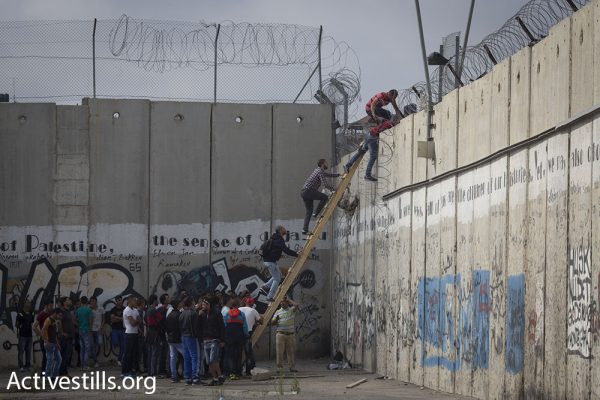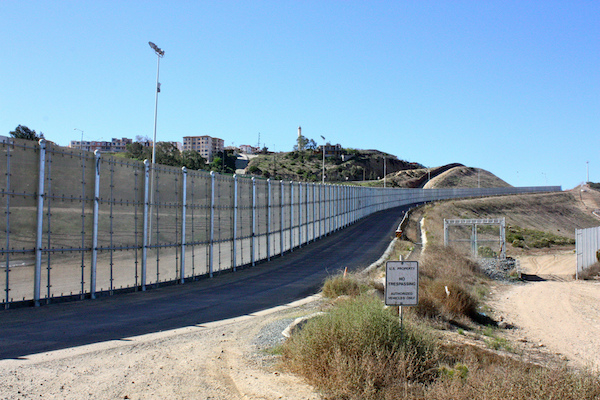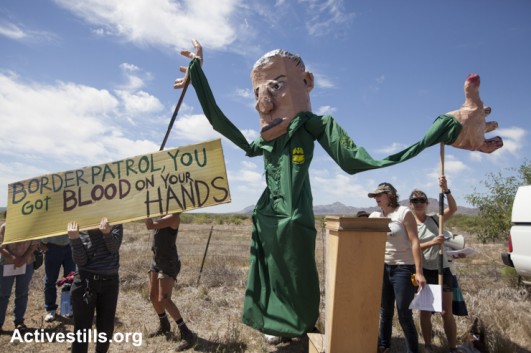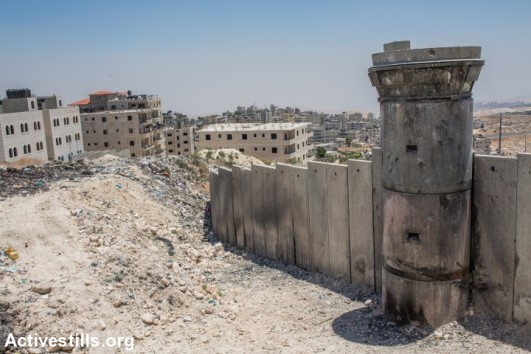Donald Trump’s proposal to build a wall on the U.S.-Mexico border was a cornerstone of his presidential campaign. But Israel’s separation wall is a lesson in why such a project is dangerous, ineffective — and morally wrong.
By Abby C. Wheatley and Oren Kroll-Zeldin

Throughout his campaign, President-elect Donald Trump made constant reference to the 50-foot tall concrete wall he plans to build on the entire length of the U.S.-Mexico border. Trump’s plan is divisive, further polarizing an already fractured American public. And yet there seems to be little public awareness that nearly 700 miles of fencing already exists, or that thousands of migrants have died attempting to cross the border, a well-documented consequence of border security.
The current border fence creates deadly conditions for people in transit while further dividing border communities that have long coexisted. But Trump’s public presence and demagogic rhetoric distracts from these realities, and ignores well-documented historical evidence that no border can be fully secured with a wall.
Trump’s wall is poorly conceived and doomed to fail not only because it would be nearly impossible (and inordinately expensive) to build, but also because a wall does not prevent migration or address the social, political, and economic conditions that drive it. Moreover, building a wall would actually fortify underground economies and fuel illicit cross-border traffic. Legally restricting the mobility of people does not stop cross-border movement; it pushes it underground, exacerbating conditions of insecurity and violence in these regions.
A comparison of the separation wall in Israel-Palestine and the U.S.-Mexico border provides ample evidence of this reality. The U.S.-Mexico border fence has not stopped undocumented migration just as Israel’s separation wall has not prevented Palestinians from entering Israel. In both cases, however, the construction of a barrier has amplified tensions and violence. As the U.S. government considers building an enhanced and more restrictive border wall, we should work to avoid the pitfalls of the separation wall.
As anthropologists and activist-researchers, we have witnessed the impacts of “securing” the border through our ethnographic research on the U.S.-Mexico and Israel-Palestine borderlands. Our experiences have led us to conclude that an impermeable border—one that is difficult to cross through legal or regulated means—is a dangerous and violent border. A permeable border can save lives, improve cross-border relations, and reduce violence in volatile border regions.
U.S.–Mexico border wall
The guiding principle of U.S. border security transformed in 1994 as policy aimed to prevent migration through deterrence. This strategy, which aims to deter migration by making crossing the border so dangerous that people will stop attempting it, was first implemented in El Paso/Juarez and San Diego/Tijuana (Phase I), and later in Nogales and South Texas (Phase II). Its strategy was to “close” urban areas where migrants historically (and more safely) crossed, while leaving more remote migration paths “open.”

This has indeed shifted migrant traffic from one area of the border to another, funneling migrants through the most remote corridors of the desert, and raising the risk of crossing to deadly levels. As a result, thousands of people have died or disappeared in the vast desert, evidenced by the remains of 6,571 migrants recovered along the southwestern border between 1998 and 2015.
Despite how deadly and difficult crossing has become, the border wall and fence has not stopped migration. It has transformed where and how people cross the border. It has extended the migrant trail across time and space, created new and varied dangers facing people in transit, and changed daily life on the border. But it has not prevented migration. For instance, the wall has not deterred the hundreds of thousands of Central Americans escaping gang violence in urban centers in Honduras, Guatemala, and El Salvador. Although migrating is exceptionally dangerous and often deadly, the possibility of safety in the U.S. outweighs the almost certain death sentence at home.
The wall has also failed to stop repeat attempts by Mexican nationals to return to the United States after being deported. Many of these individuals have lived in the United States for most of their adult lives. They have U.S.-born children and spouses, they own homes in the United States, and they pay taxes. Their children attend local schools and they are active members of the communities they inhabit. Returning to Mexico is not an option for them because their homes, families, jobs, and lives are all in the United States. Simply put, nothing will prevent them from returning home.
Trump’s plan is historically myopic and disregards the political dynamics that shape the fundamental relationship between the United States and Mexico. The Mexican-American War (1846-1848) and the Treaty of Guadalupe Hidalgo (1848), in which over fifty percent of Mexico’s territory was ceded to the United States, created a border region with more cultural, linguistic, and ethnic continuities than differences.
The proposed wall disregards a long history of labor relations, typified by the Bracero Program (1942-1964), which brought thousands of Mexican workers to the United States at the request of U.S. companies to fill a labor need that initially arose during World War II. It ignores the implications of economic agreements such as NAFTA (the North American Free Trade Agreement, 1994) that have generated new migrants, as Mexicans working in agriculture were displaced from their land because their corn crops could not compete globally with corn subsidized in the United States.
Trump’s proposal ignores the dysfunction of our immigration system, which provides no path to citizenship for many people who live and work in the United States, including those who came to this country as young children. Although the Dream Act, first introduced in 2001, has been debated by Congress for over a decade, it remains a fantasy for thousands of young people who participate in and contribute to their schools, communities, and families.

Despite the geographic proximity of Mexico to the United States, the fact that Mexico is part of North America, and the intertwined histories of these two nations, the U.S. immigration system does Mexico no favors. As a result, even Mexican nationals who have family sponsors, meeting the family-based requirements of the immigration system, face a 20-year wait to migrate legally to the United States.
The construction of a larger, more restrictive border wall will not fix our immigration system, nor will it provide reasonable options to these families.
Israel–Palestine separation wall
Numerous pundits and activists have referred to the Israeli separation wall as the muse for Donald Trump’s border wall. Though the geographic, political, historical, and cultural contexts of the two walls are dramatically different, the ways in which Israel’s wall seeks to function as a mechanism of security can shed light on some of the misguided intentions of Trump’s wall. A brief examination of the separation wall can also illuminate the potential pitfalls of constructing a non-permeable barrier along the entire U.S.-Mexico border.
Israel began construction on the separation wall in 2002 in order to protect its citizens from increased Palestinian militant resistance during the Second Intifada, a major Palestinian uprising against Israeli policies of occupation. The current route of the wall meanders 441 miles through contested territory. It is more than double the length of the Green Line, the internationally recognized border between Israel and the West Bank. Roughly 85 percent of the wall is built inside Palestinian territory, thereby unilaterally annexing large amounts of Palestinian land. Furthermore, approximately one-fifth of the wall has yet to be constructed, which leaves large swaths of land open and accessible to anyone wishing to cross the border.
The Israeli government insists that the sole function of the wall is securing its border, but it has been ineffective in preventing violence against Jewish Israelis. For one, the dramatic decrease in suicide bombings since the wall was constructed derives not from the wall but from shifting Palestinian strategies of resistance.
After losing international support due to militant tactics, Palestinian leadership called for an end to suicide bombings, instead adopting methods of popular resistance such as weekly demonstrations against the wall and a global nonviolent movement to boycott, divest from, and sanction Israel.
Secondly, though most of the recent attacks against Jewish Israelis have occurred in the occupied West Bank, many have come from Palestinians living in Jerusalem on the Israeli side of the wall.
Third, though there has been a decline in the number of Jewish Israeli fatalities since the construction of the wall, it has failed, as all border walls do, to completely prevent violence. This is evidenced by the fact that the number of attacks on Jewish Israelis in Jerusalem increased in 2015 to 635, up from 346 in 2014. In this regard, the wall does not and cannot protect Jewish Israelis, rendering it largely irrelevant as a method of security.

Despite official Israeli government rhetoric, evidence reveals that the separation wall is less about security and more about politics. It unilaterally annexes Palestinian territory, incorporates illegal Israeli settlements into Israel, and severely restricts Palestinian freedom of movement. The inevitable effect is that the wall incites further antagonism and violence towards Jewish Israelis rather than making their everyday lives more secure, as can be seen by the recent “Jerusalem Intifada” and the concurrent rise in violent attacks on Jewish Israeli civilians in Jerusalem and the West Bank.
Every day Palestinians encounter the separation wall, just one of many physical reminders of Israel’s nearly 50-year occupation. Rather than keep Jewish Israelis safe, as the Israeli government claims, the wall provokes Palestinian resistance, which actually heightens the conditions of insecurity for Jewish Israeli civilians. This in turn leads to further militarization and securitization of the border, thereby beginning again the perpetual cycles of violence and securitization.
Despite efforts to secure the region with a wall, the border remains “soft” in a variety of ways. For instance, thousands of Palestinian laborers cross the wall autonomously every day to earn the necessary wages to provide for their families. This facilitates regular interactions between Jewish Israelis and Palestinians, forcing them to come to terms with the existence of the other and rendering the separation of these communities largely ineffective. A sustainable, peaceful, and just solution to the decades-long conflict will not be achieved by a border wall, but rather depends on the recognition that Palestinians and Jewish Israelis are inextricably linked with one another.
Border (in)security
Although ample evidence exists to support the claim that an impermeable border is an insecure and unsafe one, the push to secure the U.S.-Mexico border continues unabated. The separation wall in Israel-Palestine provides yet another example of the ways in which border walls only exacerbate the dangers, tensions, and violence of these regions, creating a perpetual cycle of violence, death, and conditions of insecurity. Furthermore, border security is not an effective deterrent. Even as the journey becomes more precarious and costlier, migrants continue to attempt to cross the border and enter the United States.
Trump’s plan to build a 50-foot concrete wall could likely transform the borderlands in various ways, though evidence suggests that peace and order is the last thing it would bring. No wall can mitigate the violence erupting in urban centers in Central America, redistribute land to indigenous communities that rely on it for their livelihood, or undo the historical relationship between the U.S. economy and Mexican laborers that has guided the last one hundred years of migration between these two North American countries. Nor can any wall completely deter migrant attempts to cross, especially when their families and homes are north of the border.
What the wall actually does is create and reproduce conditions of insecurity for people in transit and communities on both sides of the international divide. Regardless of this reality, or perhaps in spite of it, migrants and border communities in Mexico, Palestine, and beyond continue to devise creative strategies to overcome the consequences of border fortification.
In order to save lives and reduce the danger that these policies create, we must work to demilitarize the borderlands, build and maintain social connections that extend beyond the border, and actively engage with our neighbors. We want a permeable border, not a wall. The lives of many people on both sides of these international divides depend on it.
Abby C. Wheatley has a Ph.D. in Social and Cultural Anthropology. Her work focuses on international migration and the U.S.-Mexico border.
Dr. Oren Kroll-Zeldin is a cultural anthropologist who teaches in the Jewish Studies and Social Justice program at the University of San Francisco. He researches the systematic and physical exclusion of Palestinians from Jerusalem.
This article was originally published on NACLA. It is reprinted here with permission.

